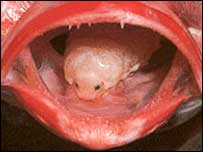Wow. I don’t know if I told you about when Jody and I went to the Dallas Zoo a couple weeks ago, but Sunday we did one better and went to the Dallas World Aquarium. It was amazing, probably due to it being newer than the zoo and more expensive. They do a good job of moving you through the exhibits while conveying a sense of moving through the various ecological niches. Rainforest to river to ocean. The best parts were as follows:
- Giant river otters – Two playful river otters who look like long skinny dogs. They swam around their cage and would swim up to the glass to gawk at the humans. Up close you can see the massive jaws they use to crush the heads of fish. Very cat-like in the skull area. Flattened muscular tails they use like oars. Beautiful creatures.
- Antillean manatees – These are like the Florida manatee except they’re thinner and smaller. I pegged them incorrectly as dugongs (another member of Sirenia) because they just didn’t look like your normal manatee. Up close you can see them much better. One thing I was surprised about was the long hairs protruding from their fat grey bodies just like elephants, which is not surprising since they are closely related, I believe. In the manatee tank they had all sorts of other fish, catfish, and side-necked turtles. Some very huge arapaima also, which are air breathing fish that grow up to fourteen feet.
- Three-toed sloth – The sloth was so cute and amazing. From it’s mossy fur to its Mona Lisa smile, it is easily one of the most adorable animals you will see. I learned something interesting, sloths live in trees full-time, but they come to ground to defecate. How tidy!
- A few other animals I loved: the cuttlefish with their color-changing chromatophores, the sleepy jaguar, seadragons, and the smiling stingrays who flapped against the glass expecting food.
Whenever you’re in Dallas, be sure to check out the aquarium. It’s worth it. Here’s a link to the otter and manatee webcams. Updating live.
